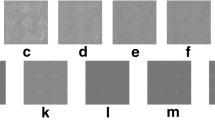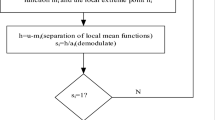Abstract
This paper presents a new method for BEMD. BEMD can decompose a source image into several two-dimensional intrinsic mode functions. During the image decomposition process, it is required to interpolate and draw the upper and lower envelopes. However, these interpolations and drawing the enveloping surface require a large amount of computing time and artificial screening. Thus, some scholars proposed the rapid realization of BEMD. Further, the window size being fixed during the decomposition process led to losses in the data-driven characteristics, adaptability and dimension consistency of the original BEMD. Therefore, this paper proposes a simple but effective means of keeping the original BEMD method features. The estimate reconstruction method is used to replace surface interpolation, and the variable neighborhood window method is adopted to replace the fixed neighborhood window method. In this article, an order filter is used to reconstruct the upper and lower envelopes, and then the filter size is obtained by using the fact that the image information itself is adaptively variable. Through an empirical analysis, this paper shows that this method can keep the original BEMD method’s rapid decomposition, data-driven characteristics, adaptivity and consistency of scale.















Similar content being viewed by others

References
An FP, Lin DC, Zhou XW et al (2015) Enhancing image denoising performance of bidimensional empirical mode decomposition by improving the edge effect. Int J Antennas Propag 2015:1–12
An FP, Lin DC, Zhou XW, Sun Z (2015) Enhancing image denoising performance of bidimensional empirical mode decomposition by improving the edge effect. Int J Antennas Propag
Bhuiyan SMA, Adhami RR, Khan JF (2008) A novel approach of fast and adaptive bidimensional empirical mode decomposition. Proc IEEE International Conference on Acoustics, Speech and Signal Processing. 1313–1316
Bhuiyan SMA, Adhami RR, Khan JF (2008) Fast and adaptive bidimensional empirical mode decomposition using order-statistics filter based envelope estimation. EURASIP J Adv Signal Process 2008(4):1–18
Bhuiyan SMA, Adhami RR, Khan JF (2008) Fast and adaptive bidimensional empirical mode decomposition using order-statistics filter based envelope estimation[J]. EURASIP J Adv Signal Process 2008(1):728356
Brodatz P (1966) Textures: a photographic album for artists and designers. Dover Publications, New York
Cai B, Xiang J (2011) Digital image compression based on BEMD and PCA [J]. Comput Eng Appl 47(23):185–187
Cuiyun L, Pan H, Hongbing J (2011) A novel surface interpolation approach for bidimensional empirical mode decomposition[C]. In Network Computing and Information Security (NCIS) International Conference on, pp 335–338
Damerval C (2005) A fast algorithm for bidimensional EMD. IEEE Signal Process Lett 12(10):701–704
Ge G-t, Sang E-f, Liu Z-f et al (2010) Novel BEMD criterion for stopping sifting process. J Data Acquis Process 25(2):195–200
Haddadpour M, Daneshvar S, Seyedarabi H (2017) PET and MRI image fusion based on combination of 2-D Hilbert transform and IHS method[J]. Biom J 40(4):219–225
He Z, Wang Q, Shen Y et al (2013) Multivariate gray model-based BEMD for hyperspectral image classification. IEEE Trans Instrum Meas 62(5):889–904
HE Z et al (2013) Discrete multivariate gray model based boundary extension for bi-dimensional empirical mode decomposition. Signal Process 93(1):124–138
Hu J, Wang X, Qin H (2014) Improved, feature-centric EMD for 3D surface modeling and processing [J]. Graph Model 76(5):340–354
Huang NE, Shen Z, Long SR et al (1998) The empirical mode decomposition and the Hilbert spectrum for non-linear and non-stationary time series analysis. Proc R Soc Lond A 454(12):903–995
Huang NE, Wu M-LC, Long SR et al (2003) A confidence limit for the empirical mode decomposition and Hilbert spectral analysis. Proc R Soc A 459(2037):2317–2345
Kim D, Park M, Oh HS (2012) Bidimensional statistical empirical mode de- composition. IEEE Signal Process Lett 19(4):191–194
Liu Z, Peng S (2005) Boundary processing of bidimensional EMD using texture synthesis. IEEE Signal Process Lett 12(1):33–36
Liu H, Sun D, Xiong K et al (2014) A hybrid approach to protect palmprint templates[J]. Sci World J (2014-3-27), 2014, 2014(12):686754
Liu H, Sun D, Xiong K et al (2014) Palmprint based multidimensional fuzzy vault scheme [J]. Sci World J 2014(1):819031
Lu H, Zhang L, Serikawa S (2012) Maximum local energy: an effective approach for multisensor image fusion in beyond wavelet transform domain [J]. Comput Math Appl 64(5):996–1003
Nan D, Bi D-y, Xu Y-l et al (2011) Retinex color image enhancement based on adaptive bidimensional empirical mode decomposition. J Comput Appl 31(6):1552–1559
Nunes JC, Bouaouue Y, Delechelle E et al (2003) Image analysis by dimensional empirical mode decomposition. Image Vis Comput 21(3):1019–1026
Nunes JC, Guyot S, Delechelle E (2005) Texture analysis based on local analysis of the bidimensional empirical mode decomposition. Mach Vis Appl 16(5):177–188
Qiao LH, Niu KF, Wang N et al (2011) Perfect reconstruction image modulation based on BEMD and quaternionic analytic signals. Sci China Inf Sci 54(12):2602–2614
Rilling G, Flandrin P, Gancalves P (2003) On empirical mode decomposition and its algorithms. Proc IEEE-EURASIP Workshop Nonlinear Signal Image Process 3:8–11
Trusiak M, Patorski K (2012) Space domain interpretation of incoherent moiré superimpositions using FABEMD. Proc 18th Czech-Polish-Slovak Optical Conference on Wave and Quantum Aspects of Contemporary Optics. 869704–869708
Trusiak M, Patorski K (2013) Processing and phase analysis of fringe patterns with contrast reversals. Opt Express 21(19):22596–22609
Van Tung T, Yang B-S, Gu F et al (2013) Thermal image enhancement using bi-dimensional empirical mode decomposition in combination with relevance vector machine for rotating machinery fault diagnosis. Mech Syst Signal Process 38(2):601–614
Wu Z, Huang NE, Chen X (2009) The multi-dimenstional ensemble empirical mode decomposition method. Adv Adapt Data Anal 1(5):339–372
Xiong CZ, Xu JY, Zou JC et al (2006) Texture classification based on EMD and FFT. J Zhejiang Univ (Sci A) 7(9):1516–1521
Yang ZH, Qi DX, Yang LH (2004) Signal period analysis based on Hilbert-Huang transform and its application to texture analysis[C]. IEEE Proc Third Int Conf on Image and Graphics pp 430–433
Ye Q, Xiang M, Cui Z (2012) Fingerprint image enhancement algorithm based on two dimension emd and gabor filter. Procedia Eng 29:1840–1844
Acknowledgements
This work is supported by National Science Foundation Project of P. R. China (No. 61701188) and the Foundation of Science and Technology on Information Assurance Laboratory (No.KJ-17-101).
Author information
Authors and Affiliations
Corresponding author
Additional information
Publisher’s Note
Springer Nature remains neutral with regard to jurisdictional claims in published maps and institutional affiliations.
Rights and permissions
About this article
Cite this article
Ma, X., Zhou, X. & An, F. Fast Bi-dimensional empirical mode decomposition(BEMD) based on variable neighborhood window method. Multimed Tools Appl 78, 8889–8910 (2019). https://doi.org/10.1007/s11042-018-6629-6
Received:
Revised:
Accepted:
Published:
Issue Date:
DOI: https://doi.org/10.1007/s11042-018-6629-6



